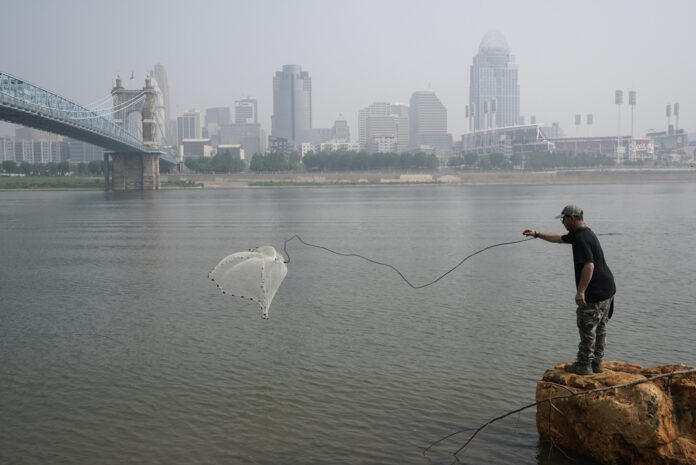
DETROIT (AP) — Smoky air from Canada’s wildfires shrouded broad swaths of the U.S. from Minnesota to New York and Kentucky on Wednesday, prompting warnings to stay inside and exacerbating health risks for people already suffering from industrial pollution.
The impacts are particularly hard on poor and minority communities that are more likely to live near polluting plants and have higher rates of asthma. Detroit, a mostly Black city with a poverty rate of about 30%, had some of the worst air quality in the U.S. on Wednesday, prompting the Environmental Protection Agency to warn that “everyone should stay indoors.”
“The more breaths you’re taking, you’re inhaling, literally, a fire, camp smoke, into your lungs,” said Darren Riley, who was diagnosed with asthma in 2018, a few years after arriving in Detroit.
“Many communities face this way too often,” said Riley, who is Black. “And while this wildfire smoke allows, unfortunately, many people to feel this burden, this is a burden that far too long communities have faced day in and day out.”
The EPA’s AirNow.gov site showed cities including Chicago, Detroit, Indianapolis and Cleveland, Ohio, had “very unhealthy air” as of Wednesday afternoon. A wider circle of unhealthy air spread into Pittsburgh, St. Louis and Louisville, Kentucky.
Earlier this month, smoke from the wildfires blanketed the U.S. East Coast for days.
Another round of drifting smoke from the wildfires was moving through western Pennsylvania and central New York and headed toward the Mid-Atlantic, said National Weather Service meteorologist Byran Jackson. In Canada, smoke will migrate across Quebec and Ontario over the next few days, Environment and Climate Change Canada meteorologist Steven Flisfeder said.
In the U.S., the smoke is exacerbating air quality issues for poor and Black communities that already are more likely to live near polluting plants, and in rental housing with mold and other triggers.
Detroit’s southwest side is home to a number of sprawling refineries and manufacturing plants. It is one of the poorest parts of the city. According to a 2022 report by the American Lung Association, the city’s and short-term particle pollution ranked among the worst in the nation.
“Being close to those refineries — that’s an environmental factor that’s difficult to control,” said Dr. Ruma Srivastava, a pediatric pulmonologist at Children’s Hospital of Michigan in Detroit. “It does increase their risk for asthma flareups. For them, it’s even more important to follow the (air quality safety) recommendations.”
Riley’s own experiences prompted him to start JustAir, which provides air pollution monitoring.
“Just because you’re born in a certain ZIP code or you’re born into a certain family with a certain skin color doesn’t mean that you should have an unequal go at it,” he said.
Elsewhere, Milwaukee County Emergency Medical Services has seen a spike in calls for residents with respiratory complaints, the Milwaukee Journal Sentinel reported. Office of Emergency Management data show a disproportionate amount of calls for respiratory issues – 54.8% – have been for Black people in Milwaukee, according to the newspaper. Milwaukee County’s population is 27.1% Black.
In Chicago, where about 29% of the population is Black, Mayor Brandon Johnson urged young people, older adults and residents with health issues to spend more time indoors. He pledged “swift action to ensure that vulnerable individuals have the resources they need to protect themselves and their families.”
President Joe Biden visited the nation’s third-largest city on Wednesday to promote his renewable energy policies. Biden has described the Canadian wildfires as clear evidence of climate change.
Minnesota issued a record 23rd air quality alert for the year through late Wednesday night, as smoky skies obscured the skylines of Minneapolis and St. Paul. Michigan, Wisconsin and Indiana were among other states issuing air quality alerts, and cities including Louisville also advised people to limit prolonged or intense outdoor activity.
“This is particularly thick smoke,” Jackson, with the National Weather Service, said.
Across Canada, 490 fires are burning, with 255 of them considered to be out of control. The Canadian Interagency Forest Fire Centre reported Monday that 76,129 square kilometers (29,393 square miles) of land including forests has burned across Canada since Jan. 1. That exceeds the previous record set in 1989 of 75,596 square kilometers (29,187 square miles), according to the National Forestry Database.
“As long as the fires are burning and the smoke is in the atmosphere it is going to be a concern not just for Canadians but Americans as well,” Flisfeder, the Canadian meteorologist, said.
The small particles in wildfire smoke can irritate the eyes, nose and throat, and can affect the heart and lungs, making it harder to breathe. Health officials say it’s important to limit outdoor activities to avoid breathing in the particles.
The warming planet will produce hotter and longer heat waves, making for bigger, smokier fires, said Joel Thornton, professor and chair of the department of atmospheric sciences at the University of Washington.
Quentin Hernandez, a 24-year-old event planner from Detroit, was out skateboarding for about an hour Wednesday at a skate park near the Ambassador Bridge, which connects the city and Windsor, Ontario.
“It just sits like this all day,” said Hernandez, saying that it smelled like being at a barbecue. “Literally, the smoke just sits in the air.”


